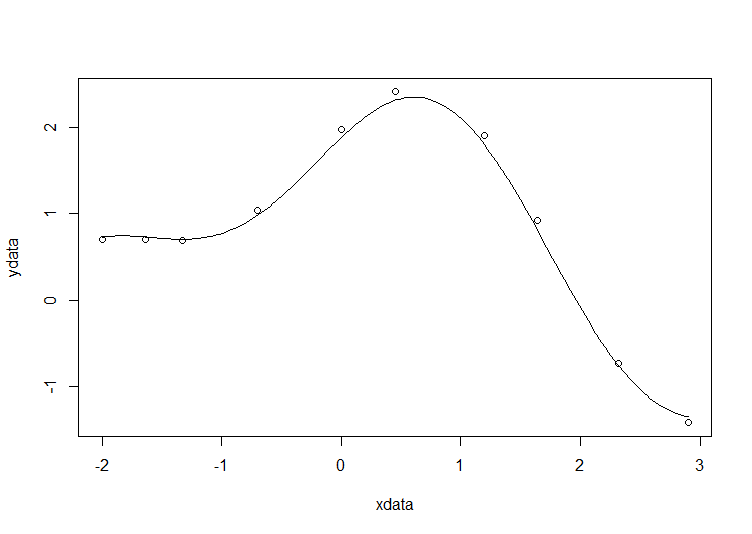Simple nonlinear least squares curve fitting in R
The R code used for this example comes from Barry Rowlingson, so huge thanks to him.
A question I get asked a lot is ‘How can I do nonlinear least squares curve fitting in X?’ where X might be MATLAB, Mathematica or a whole host of alternatives. Since this is such a common query, I thought I’d write up how to do it for a very simple problem in several systems that I’m interested in
This is the R version. For other versions,see the list below
- Simple nonlinear least squares curve fitting in Julia
- Simple nonlinear least squares curve fitting in Maple
- Simple nonlinear least squares curve fitting in Mathematica
- Simple nonlinear least squares curve fitting in MATLAB
- Simple nonlinear least squares curve fitting in Python
The problem
xdata = -2,-1.64,-1.33,-0.7,0,0.45,1.2,1.64,2.32,2.9 ydata = 0.699369,0.700462,0.695354,1.03905,1.97389,2.41143,1.91091,0.919576,-0.730975,-1.42001
and you’d like to fit the function
![]()
using nonlinear least squares. You’re starting guesses for the parameters are p1=1 and P2=0.2
For now, we are primarily interested in the following results:
- The fit parameters
- Sum of squared residuals
- Parameter confidence intervals
Future updates of these posts will show how to get other results. Let me know what you are most interested in.
Solution in R
# construct the data vectors using c() xdata = c(-2,-1.64,-1.33,-0.7,0,0.45,1.2,1.64,2.32,2.9) ydata = c(0.699369,0.700462,0.695354,1.03905,1.97389,2.41143,1.91091,0.919576,-0.730975,-1.42001) # look at it plot(xdata,ydata) # some starting values p1 = 1 p2 = 0.2 # do the fit fit = nls(ydata ~ p1*cos(p2*xdata) + p2*sin(p1*xdata), start=list(p1=p1,p2=p2)) # summarise summary(fit)
This gives
Formula: ydata ~ p1 * cos(p2 * xdata) + p2 * sin(p1 * xdata) Parameters: Estimate Std. Error t value Pr(>|t|) p1 1.881851 0.027430 68.61 2.27e-12 *** p2 0.700230 0.009153 76.51 9.50e-13 *** --- Signif. codes: 0 ‘***’ 0.001 ‘**’ 0.01 ‘*’ 0.05 ‘.’ 0.1 ‘ ’ 1 Residual standard error: 0.08202 on 8 degrees of freedom Number of iterations to convergence: 7 Achieved convergence tolerance: 2.189e-06
Draw the fit on the plot by getting the prediction from the fit at 200 x-coordinates across the range of xdata
new = data.frame(xdata = seq(min(xdata),max(xdata),len=200)) lines(new$xdata,predict(fit,newdata=new))

Getting the sum of squared residuals is easy enough:
sum(resid(fit)^2)
Which gives
[1] 0.0538127
Finally, lets get the parameter confidence intervals.
confint(fit)
Which gives
Waiting for profiling to be done...
2.5% 97.5%
p1 1.8206081 1.9442365
p2 0.6794193 0.7209843

Of course, I had to try this in Euler. Find the solution on
http://observations.rene-grothmann.de/non-linear-fit-in-euler-math-toolbox/
Yours, R.G.
You say “This is the MATLAB version. For other versions,see the list below” – Should be “This is the R version. For other versions,see the list below”
Thanks…a copy and paste error. Fixed now :)
Thanks R.G. — looks good
Fun exercise. I posted a solution to the JMP blog using the JMP scripting language.
http://blogs.sas.com/content/jmp/2013/12/18/simple-nonlinear-least-squares-curve-fitting-in-jmp/
Thanks , very good,Now, i am starting to know the nls and curve fitting a little bit,
Thanks for this tutorial, very helpful!
I would like to fit the nonlinear equation using r for the data set, how do I get it right
Day %Cum aggregates
0 0
15 0
45 0
75 4.5
105 19.7
135 39.5
165 59.2
195 77.1
225 93.6
255 98.7
285 100
315 100
Fit1 equation
100*(1+((p1*x)^p2)^-(1-1/p2))^-p3)
x=day, y=%Cumulative aggregate
where p1,p2,p3 are parameters (initial p=0.01, p2=10, p3=0.5
Fit2 equation
100*(1+((p1*x)^p2)^-(1-1/p2))^-0.5)
x=c(0,15,45,75,105,135,165,195,225,255,285,315)
y=c(0,0,0,4.5,19.7,39.5,59.2,77.1,93.6,98.7,100,100)